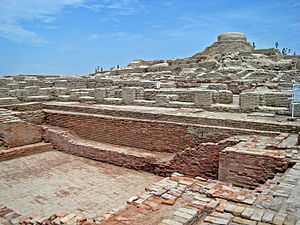Great Bath, Mohenjo-daro

The Great Bath is one of the best-known structures among the ruins of the ancient Indus Valley Civilization at Mohenjo-daro in Sindh, Pakistan.[1][2] Archaeological evidence indicates that the Great Bath was built in the 3rd Millennium BCE, just sometime after raising of the "citadel" mound on which it is located.[3]
Features
The Great Bath of Mohenjodaro is called the "earliest public water tank of the ancient world"[4] The Great Bath measures 11.88 metres x 7.01 metres, and has a maximum depth of 2.43 metres. Two wide staircases, one from the north and one from the south, served as the entry to the structure.[5] A 1 meter wide and 40 centimeters mound is present at end of these stairs.
The Great Bath is built of fine baked mud bricks lined with bitumen (natural tar – presumably to keep water from seeping through), which indicates that it was used for holding water. Many scholars have suggested that it could have been a place for ritual bathing or religious ceremonies, but the actual use is not clear.[1]
College of Priests
Across the street of Great Bath, there was a large building having several rooms and three verandas, with two staircases leading to roof and upper floor; and considering the size and proximity to Great Bath, this building is tentatively termed as house of Priest/several priests and labelled as "college of priests".[3]
Discovery
It was found in 1926 during Archaeological excavations.
Currency of Pakistan
The site of Mohenjo-daro is depicted in the Pakistani rupee 20 Rs.
References
- ↑ 1.0 1.1 SD Area. Ancient Museum. British India.
- ↑ "Great Bath." Encyclopædia Britannica. 2010. Encyclopædia Britannica Online. 9 June 2010.
- ↑ 3.0 3.1 Singh, Upinder (2008). A history of ancient and early medieval India : from the Stone Age to the 12th century. New Delhi: Pearson Education. pp. 149–150. ISBN 978-81-317-1120-0.
- ↑ Harappa, com. ""Great Bath" Mohenjadaro". slide show with description by J.M.Kenoyer. Harappa.com. Retrieved 2 July 2012.
- ↑ Great Bath, SD Area, looking north.